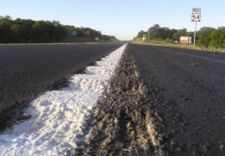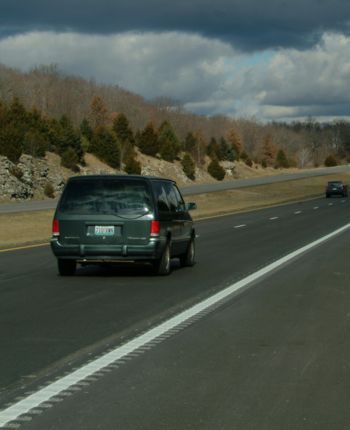Category:626 Rumble Strips

| Forms |
| Design Exception Information Form |
| Passing Lane Special Sheet |
Rumble strips are a grooved pattern in the pavement that make road travel safer for motorized vehicles. The grooves alert drivers by causing the vehicle’s wheels to noisily and suddenly vibrate when it leaves the driving lane.
This article deals with both edgeline and centerline rumble strips as well as the construction inspection guidelines that must be considered to achieve a high-quality product.
626.1 Edgeline Rumble Strips

Edgeline rumble strips are used to enhance safety on every shoulder at least 2 ft. wide, unless the shoulder has a curbed section or is intended to be used as a future travel lane. Rumble strips are omitted where the posted speed is less than 50 mph. All major roads will have edgeline rumble strips unless the posted speed is less than 50 mph. In urban areas, edgeline rumble strips may be omitted on major roads with a design exception (e.g., noise is a significant issue and safety is not a significant issue).
Edgeline rumble strips may be used on minor roadways as a specific safety countermeasure with a paved shoulder. Where several sections of edgeline rumble strips are installed in close proximity, continuity should be maintained.
Edgeline rumble strips are to be milled into bituminous and portland cement concrete. Milling has little or no effect on the integrity of the pavement structure and milled rumble strips produce greater noise and vibration than rolled or formed rumble strips. Refer to Standard Plan 626.00 for details. Edgeline rumble strips are omitted between the radius points for side road approaches, entrances and median crossovers. Edgeline rumble strips should be omitted on bridges and on ramps for diamond, single point, partial cloverleaf and similar types of interchanges, but may be considered on longer ramps for directional or other large interchanges. The length of edgeline rumble strip installation is to be estimated and pay items provided.
Durable, highly reflective edgeline pavement marking material is sprayed over the rumble strip, creating what is often called a “rumble stripe.” The pavement marking material is a tape with a raised pattern that causes it to be as visible as possible to the driver.
626.2 Centerline Rumble Strips

All two-lane major roads with new pavement will have centerline rumble strips (see figure at right) unless the posted is less than 50 mph. Centerline rumble strips are provided on all major two-lane roads, and on minor roads with a cross-centerline accident history. Rumble strips on a centerline have been shown to reduce head-on crashes by alerting drivers that they are leaving their lane of travel. On roadways with a travelway width of 20 ft., centerline rumble strips become obtrusive and are not recommended.

As with edgeline rumble strips, durable, highly reflective pavement marking material is sprayed over the centerline rumble strip, creating what is often called a “rumble stripe.”
Rumble strips in the median of typical passing lane roadways (see Passing Lanes Special Sheet) vary somewhat from centerline rumble strips on typical two-lane roadways (see figure below). Passing lanes can operate effectively with no separation between opposing lanes of travel. While no separation is required, AASHTO guidance recommends that some separation, however small, between the lanes in opposite directions of travel is desirable. Therefore, a flush separation of 4 ft. (1.2 m) between the opposing directions of travel is preferred (see typical section), if at all possible.
In order to maintain the integrity of the rumble strip and the pavement, the pavement material must be either concrete or the final lift of bituminous material must be least 1 3/4 in. thick, and the pavement must have a final asphalt thickness of at least 3 3/4 in. Centerline rumble strips are not to be placed on bridges or within the limits of an intersection with left turn lanes. The limits of the intersection are defined by the beginning of the tapers for the left turn lanes. Centerline rumble strips are not to be placed on any joint. Longitudinal joints shall be offset 10 in. to accommodate the width of the rumble strip. The length of centerline rumble strip installation should be estimated and pay items provided.
Articles in "626 Rumble Strips"
The following 5 pages are in this category, out of 5 total.